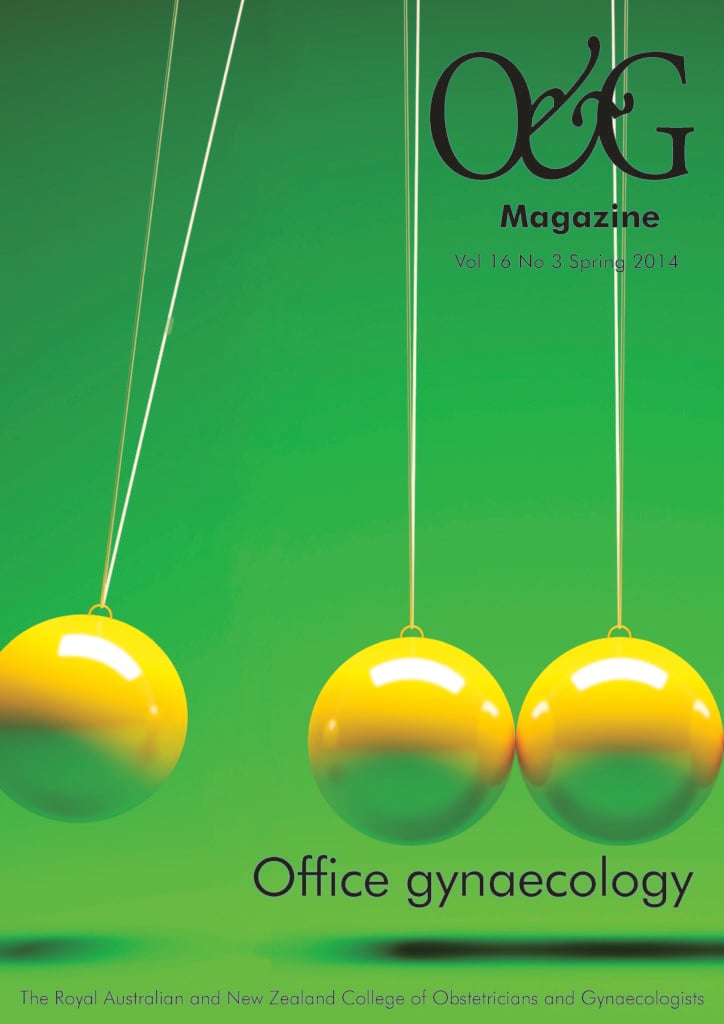The focus of contraceptive practice in Australia is changing1 to highlight the benefits of long-acting reversible contraception.
There is strong evidence to prioritise long-acting reversible contraception (LARC) to reduce rates of unintended pregnancy.2 By putting evidence into practice, a well-informed doctor can promote benefits of LARC and remove unnecessary barriers to their use.3 In this article we also provide guidance on management of problematic bleeding on progestogen-only LARC and describe how to initiate contraception without delay.
LARC is considered the best first-line option for all women, particularly young women who have higher rates of fertility and unintended pregnancy.4 LARC methods include hormonal IUD (Mirena®), copper IUDs and the contraceptive implant (Implanon NXT®). Contraception efficacy and continuation are important factors in reducing unintended pregnancy, with these methods rating highly on both.5
Table 1. The CHOICE Project: cumulative percentage of contraceptive failure at one, two or three years by contraceptive method.6
| Cumulative failure rate | At one year | At two years | At three years |
|---|---|---|---|
| LARC | 0.3% | 0.6% | 0.9% |
| Injection (DMPA) | 0.1% | 0.7% | 0.7% |
| Pill, patch and ring | 4.8% | 7.8% | 9.4% |
Table 2. The CHOICE Project: continuation and satisfaction rates of LARC versus non-LARC.5, 8
| 24 month continuation rates, all ages | 24 month continuation rates, women 14–19 years | 12 month satisfaction rates | |
|---|---|---|---|
| LARC | 76.6% | 66.5% | 83.7% |
| Non-LARC (DMPA, pill, patch and ring) | 40.9% | 36.6% | 52.7% |
A recent large prospective study in the USA, the Contraceptive CHOICE Project, reported on contractive failure, continuation and satisfaction rates (see Table 1, Table 2).6 This study showed that women who used non-LARC were 20 times more likely to have an unintended pregnancy than those who used LARC [Adjusted Hazard Ratio 21.8: 95 per cent CI, 13.7 to 34.9].6 Women using a non-LARC who are less than 21 years of age had almost double the risk of unintended pregnancy than older women.
The contraceptive injection DMPA (Depo Provera®, Depo Ralovera®) has efficacy rates comparable to other LARC, but a poor continuation rate (DMPA 38 per cent versus LARC 76.6 per cent continuation rates at 24 months).5
he CHOICE Project demonstrated reduction in unintended pregnancy, with a reduction in teenage birth rates to 6.3/1000 women in the study group compared with 34.3/1000 women in the US population. They also reported a decrease in the number of repeat abortions.7 Reduction in unintended pregnancy and abortion rates has been achieved in the UK, coinciding with a national strategy promoting use of LARC.
LARC have few contraindications and the majority of women, including young women and nulliparous women, are eligible to use implants and IUDs.9 LARC methods can have additional non-contraceptive benefits, such as reduction in dysmenorrhoea with the implant, and reduction in menstrual bleeding and dysmenorrhoea with the hormonal-IUD.10 The copper IUD is the most effective reversible method for women who require or desire a non-hormonal method.
Despite the many advantages of LARC, the uptake in Australia is low.1 The combined pill and condoms are the most commonly used reversible methods in Australia, with women having low awareness of the benefits of LARC. Data from 2003 shows relatively high termination of pregnancy rates in Australia at 19.7 per 1000 women aged 15–44 years, however, these rates may have changed since.4 Two-thirds of teenage pregnancies are unintended and half of teenage pregnancies end in termination of pregnancy. Contraceptive implants can be initiated immediately postpartum and IUDs inserted within 48 hours of, or from four weeks after, childbirth including after lower segment caesarean section.9 LARC initiation at the time of termination of pregnancy is more effective at reducing subsequent pregnancy than initiating other methods.11
Doctors may have a perceived risk of infection and infertility with IUDs12 based on older devices and less effective chlamydia screening and thus limit their use for younger women. While there is a small increase in infection in the three weeks following IUD insertion (less than one in 300), there is no evidence of increased risk of pelvic infection after that time and no association with infertility.13 Women diagnosed with an STI with an IUD in situ may often be managed with the IUD retained, unless they have pelvic inflammatory disease that fails to respond to antibiotics. Nulliparity is not a contraindication to IUD insertion9 and in most cases insertion is not technically difficult.
Frequent and/or prolonged bleeding with the contraceptive implant can be frustrating and is the most common reason for discontinuation of this method. However, around 75 per cent of women experience infrequent bleeding or amenorrhoea.9,14 Patient satisfaction with amenorrhoea and light irregular bleeding may increase with explanation and reassurance about the safety of these patterns. Women need to attend their doctor for implant removal if they wish to discontinue, which may result in a perception bias by doctors who see these unsatisfied implant users. However, evidence shows excellent continuation rates with the implant compared to non-LARC methods.5
Bleeding problems with progestogen-containing LARCs
The progestogen-only IUD, implant and injection disrupt the regular menstrual cycle and change vaginal bleeding patterns.
In women with the contraceptive implant, around 20 per cent experience amenorrhoea and 20 per cent experience heavy/prolonged bleeding initially, with 50 per cent of these improving after three months.14
The progestogen-only IUD commonly causes initial frequent spotting/bleeding for three-to-five months with frequency of bleeding decreasing by six months, after which time around 50 per cent of women have amenorrhoea.15
Bleeding is the most frequent reason for discontinuation of progestogen-only LARC. Guidance is provided in the SH&FPA Joint Statement ‘Bleeding pattern changes with progestogen-only LARC’.16 Firstly consider the need to exclude pathology by taking a sexual history, excluding pregnancy, performing cervical screening, chlamydia testing and further gynaecological investigation as indicated. Women may be offered the following options (if no contraindications):
- Any combined hormonal contraception, cyclically or continuously for around three months.
- Five-day course of NSAID (mefenamic acid 500mg twice a day).
- Five-day course of tranexaminc acid 500mg twice a day.
Return of bleeding is likely when treatment is stopped. Evidence for long-term management is lacking. However, some women may choose to use these intermittently (or a combined hormonal contraceptive used continuously) to manage their bleeding.
On the horizon
A new progestogen-only IUD, Jaydess®, has received TGA approval and is undergoing evaluation for PBS listing. Jaydess contains a lower dose of progesterone and is smaller in size than the Mirena (see Table 3).19 Some women may favour the lower hormone dose; however, bleeding reduction may not be as significant.
Quick start
Tammy is a 20-year-old marketing student who presents to your GP clinic pleading for you to insert a contraceptive implant. For the last three months she has been trying to co-ordinate the insertion of the implant; however, the timing of her period, your clinic’s hours and her study and part-time work commitments have never aligned. Tammy has been using condoms and three days ago the condom broke and she required emergency contraception. She knows that her period is at least another two weeks away, but she’s desperate for reliable contraception. ‘C’mon doc, can you help me?’
Traditionally, hormonal contraceptives are commenced early in the menstrual cycle (Day 1–5) to exclude the risk of pregnancy and ensure immediate contraception. Unfortunately, this requirement often delays administration of reliable contraception and also increases the risk that women may forget instructions. Subsequently, this may lead to increased rates of unplanned pregnancies.
Quick start refers to starting hormonal contraception outside the traditional recommended time. This allows improved uptake and immediate commencement of reliable contraception thus potentially preventing unwanted pregnancies. When using quick start, if pregnancy is first excluded (for example, a woman has a negative pregnancy test and hasn’t had unprotected intercourse in the last three weeks or has not had sex since the beginning of her last normal menstrual period, or is within 21 days postpartum or five days after termination or miscarriage) all methods of contraception can be considered. If pregnancy cannot be excluded, all methods can be used except the copper or hormonal IUD, which are associated with potential pregnancy complications. The copper IUD can be used if emergency contraception is required.
Women need to be informed about the potential for an undiagnosed pregnancy at the time of quick start contraception. However,they should be reassured that hormonal contraceptives have not been associated with teratogenicity.17 Unlike the traditional start, contraceptives are not immediately effective and use of condoms or abstinence is required for seven days (or three days in the case of the progesterone-only pill). Additionally, all women are advised that amenorrhoea and irregular bleeding are common with certain methods (for example, contraceptive implant or injection) and that their bleeding pattern should not be used as a reliable method of excluding pregnancy.
Follow up to exclude pregnancy requires a urine pregnancy test four weeks after the quick start method is commenced, regardless of any bleeding. Patients can elect to return to a practice or complete a home pregnancy test. To facilitate this last step, a standard SMS or letter recall system can be used and is strongly recommended for the implant or injection that may mask a pregnancy.
To Tammy’s relief, you were able to insert the contraceptive implant that day following a negative urine pregnancy test. Following your advice about the potential risk of pregnancy and the possibility of the implant masking pregnancy, Tammy called four weeks later thrilled to report a negative pregnancy test.
To read SH&FPA guidance on bleeding pattern changes and download Family Planning Victoria’s Quick Start consent form and protocol, visit: www.fpv.org.au/portals/health-practitioners-and-human-services/clinical-protocols/ .
Table 3. Comparison of Jaydess IUD and Mirena IUD.
| Levonorgestrel content | Levonorgestrel release | Device size | Inserter diameter | Duration | |
|---|---|---|---|---|---|
| Mirena | 52mg | 20ìg/day | 32×32mm | 4.75mm | 5 years |
| Jaydess | 13.5mg | 12ìg/day | 28×28mm | 3.80mm | 3 years |
Ulipristal acetate is a progesterone receptor modulator used for oral emergency contraception overseas and may be available in Australia in 2015. Ulipristal acetate works by delaying or inhibiting ovulation. Unlike the levonorgestrel emergency contraception (LNG-EC), it has a direct inhibition of follicular rupture and is more effective. Additionally, excessive body weight has less of an effect on Ulipristal compared to the LNG-EC. The most effective emergency contraception remains the copper IUD inserted within five days of unprotected sex.
Practice points
- IUDs and contraceptive implant have superior efficacy and continuation rates to other methods and should be recommended first line to all women seeking contraception, including young and nulliparous women.
- Attractive features of LARC for patients are that they are ‘set and forget’, are fully reversible without impacting on future fertility and have low cost for ongoing use.
- Women presenting for review of a non-LARC method such as the pill present an opportunity for a brief discussion of the benefits of LARC.
- Use of pictures, demonstration models (such as placebo implant and IUD) and counselling cards are a useful aid to increase patient understanding and confidence in LARC. For a useful efficacy counselling card and patient factsheet, visit: www.shfpa.org.au/resources-health-professionals.
- Initiation of contraception need not be delayed when using a quick start’ protocol.
References
-
- (SH&FPA) SHaFPA. Time for a change: increasing the use of long acting reversible contraceptive methods in Australia 2013.
- Black KI, Bateson D, Harvey C. Australian women need increased access to long-acting reversible contraception. Med J Aust. 2013;199(5):317-8. Epub 2013/09/03.
- Bateson D, Harvey C, Williams J, Black KI. Intrauterine contraception: why are so few Australian women using this effective method? Med J Aust. 2011;194(6):324.
- Chan A, Sage LC. Estimating Australia’s abortion rates 1985-2003. Med J Aust. 2005;182(9):447-52.
- O’Neil-Callahan M, Peipert JF, Zhao Q, Madden T, Secura G. Twenty-four-month continuation of reversible contraception. Obstet Gynecol. 2013;122(5):1083-91.
- Winner B, Peipert JF, Zhao Q, Buckel C, Madden T, Allsworth JE, et al. Effectiveness of long-acting reversible contraception. The New England Journal of Medicine. 2012;366(21):1998-2007. Epub 2012/05/25.
- Peipert JF, Madden T, Allsworth JE, Secura GM. Preventing unintended pregnancies by providing no-cost contraception. Obstet Gynecol. 2012;120(6):1291-7. Epub 2012/11/22.
- Peipert JF, Zhao Q, Allsworth JE, Petrosky E, Madden T, Eisenberg D, et al. Continuation and satisfaction of reversible contraception. Obstet Gynecol. 2011;117(5):1105-13. Epub 2011/04/22.
- Bateson D, Harvey C, McNamee K. Contraception: an Australian clinical practice handbook. 3rd ed. Brisbane 2012.
- Lindh I, Milsom I. The influence of intrauterine contraception on the prevalence and severity of dysmenorrhea: a longitudinal population study. Human Reproduction. 2013.
- Cameron ST, Glasier A, Chen ZE, Johnstone A, Dunlop C, Heller R. Effect of contraception provided at termination of pregnancy and incidence of subsequent termination of pregnancy.BJOG. 2012;119(9):1074-80.
- Mazza D. Take a fresh look at IUDs. Things have changed. Aust Fam Physician. 2002;31(10):903-7. Epub 2002/10/31.
- Farley TM, Rosenberg MJ, Rowe PJ, Chen JH, Meirik O. Intrauterine devices and pelvic inflammatory disease: an international perspective. Lancet. 1992;339(8796):785-8.
- Mansour D, Korver T, Marintcheva-Petrova M, Fraser IS. The effects of Implanon on menstrual bleeding patterns. Eur J Contracept Reprod Health Care. 2008;13 Suppl 1:13-28
- Hidalgo M, Bahamondes L, Perrotti M, Diaz J, Dantas-Monteiro C, Petta C. Bleeding patterns and clinical performance of the levonorgestrel-releasing intrauterine system (Mirena) up to two years. Contraception. 2002;65(2):129-32.
- C. Read, C. Harvey, D. Bateman, K. McNamee, T. Foran. Bleeding pattern changes with progestogen-only long-acting reversible contraceptives. 2010.
- FSRH. Quick Starting Contraception. Faculty of Sexual and Reproductive Healthcare. Clinical Effectiveness Unit; 2010.
- FPV. Clinical Operational Protocol Quick Start of contraception. 2013; Available from: www.fpv.org.au/assets/Uploads/ QuickstartFeb2014_2.pdf.
- Nelson AMD, Apter DMDP, Hauck BMD, Schmelter TP, Rybowski SM, Rosen KMD, et al. Two Low-Dose Levonorgestrel Intrauterine Contraceptive Systems: A Randomized Controlled Trial. Obstetrics & Gynecology. 2013;122(6):1205-13.
- Brache V, Cochon L, Deniaud M, Croxatto HB. Ulipristal acetate prevents ovulation more effectively than levonorgestrel: analysis of pooled data from three randomized trials of emergency contraception regimens. Contraception. 2013.
- Glasier A. Emergency contraception: clinical outcomes. Contraception. 2013;87(3):309-13.







Leave a Reply